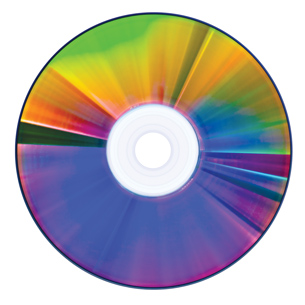Module 5
1. Module 5
1.29. Lesson 6
Module 5—Wave Theory of Light
Lesson 6—Diffraction and Interference
 Get Focused
Get Focused

© Tischenko Irina/shutterstock
If you pick up any DVD or CD and look at the disc at an angle in the sunlight, you will see a spectrum like the one in this photo. If the reflected light from the disc is directed onto a nearby screen or wall, you will see a spectrum very similar to that of the rainbow produced by refraction in a prism.
In this case, however, refraction cannot explain the pattern since the light does not pass through the disc and only travels in one medium (air). So, how is the spectrum produced? How is it comparable to the spectrum produced by refraction in a prism?
In the manufacturing of a CD or DVD, small grooves or pits are cut into the polycarbonate material in a very tightly packed spiral pattern to make a track. This pattern appears as many thousands of concentric rings on the surface of the disc. Underneath all the rings is a layer of aluminum or gold metal that makes the pits highly reflective when being read by a CD or DVD player.
As a side effect, when light is reflected from the metal layer, it is slightly bent as it emerges from the opening of each ring. The amount of bending, or diffraction, is slightly different for each colour, or wavelength of light, creating an interference pattern that reveals all the colours that make up white light.
Is this process strong evidence for the wave nature of light and EMR in general? In this lesson you will explore the wave characteristics of light.
In this lesson you will answer the following essential questions:
- What is diffraction?
- What is an interference pattern?
- What is the significance of Thomas Young’s experiment as it relates to the wave model of light?
- How are diffraction patterns solved mathematically in ideal and experimental conditions?
 Module 5: Lesson 6 Assignment
Module 5: Lesson 6 Assignment
Your teacher-marked Module 5: Lesson 6 Assignment requires you to submit responses to the following questions:
- Assignment—A 1, A 2, A 3, A 4, and A 5
- Discuss—D 3
The other questions in this lesson are not marked by the teacher; however, you should still answer these questions. The Self-Check and Try This questions are placed in this lesson to help you review important information and build key concepts that may be applied in future lessons.
After a discussion with your teacher, you must decide what to do with the questions that are not part of your assignment. For example, you may decide to submit to your teacher the responses to Try This questions that are not marked. You should record the answers to all the questions in this lesson and place those answers in your course folder.